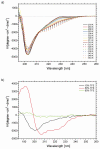Mechanism of formation of the C-terminal beta-hairpin of the B3 domain of the immunoglobulin-binding protein G from Streptococcus. IV. Implication for the mechanism of folding of the parent protein
- PMID: 20049918
- PMCID: PMC2829375
- DOI: 10.1002/bip.21365
Mechanism of formation of the C-terminal beta-hairpin of the B3 domain of the immunoglobulin-binding protein G from Streptococcus. IV. Implication for the mechanism of folding of the parent protein
Abstract
A 34-residue alpha/beta peptide [IG(28-61)], derived from the C-terminal part of the B3 domain of the immunoglobulin binding protein G from Streptoccocus, was studied using CD and NMR spectroscopy at various temperatures and by differential scanning calorimetry. It was found that the C-terminal part (a 16-residue-long fragment) of this peptide, which corresponds to the sequence of the beta-hairpin in the native structure, forms structure similar to the beta-hairpin only at T = 313 K, and the structure is stabilized by non-native long-range hydrophobic interactions (Val47-Val59). On the other hand, the N-terminal part of IG(28-61), which corresponds to the middle alpha-helix in the native structure, is unstructured at low temperature (283 K) and forms an alpha-helix-like structure at 305 K, and only one helical turn is observed at 313 K. At all temperatures at which NMR experiments were performed (283, 305, and 313 K), we do not observe any long-range connectivities which would have supported packing between the C-terminal (beta-hairpin) and the N-terminal (alpha-helix) parts of the sequence. Such interactions are absent, in contrast to the folding pathway of the B domain of protein G, proposed recently by Kmiecik and Kolinski (Biophys J 2008, 94, 726-736), based on Monte-Carlo dynamics studies. Alternative folding mechanisms are proposed and discussed.
Figures







Similar articles
-
beta-hairpin-forming peptides; models of early stages of protein folding.Biophys Chem. 2010 Sep;151(1-2):1-9. doi: 10.1016/j.bpc.2010.05.001. Epub 2010 May 6. Biophys Chem. 2010. PMID: 20494507 Free PMC article. Review.
-
Mechanism of formation of the C-terminal beta-hairpin of the B3 domain of the immunoglobulin binding protein G from Streptococcus. I. Importance of hydrophobic interactions in stabilization of beta-hairpin structure.Proteins. 2009 Jun;75(4):931-53. doi: 10.1002/prot.22304. Proteins. 2009. PMID: 19089955 Free PMC article.
-
Mechanism of formation of the C-terminal beta-hairpin of the B3 domain of the immunoglobulin binding protein G from Streptococcus. III. Dynamics of long-range hydrophobic interactions.Proteins. 2010 Feb 15;78(3):723-37. doi: 10.1002/prot.22605. Proteins. 2010. PMID: 19847914 Free PMC article.
-
Conformational studies of the C-terminal 16-amino-acid-residue fragment of the B3 domain of the immunoglobulin binding protein G from Streptococcus.Biopolymers. 2009 Jan;91(1):37-51. doi: 10.1002/bip.21080. Biopolymers. 2009. PMID: 18767128 Free PMC article.
-
Mechanism of formation of the C-terminal beta-hairpin of the B3 domain of the immunoglobulin binding protein G from Streptococcus. II. Interplay of local backbone conformational dynamics and long-range hydrophobic interactions in hairpin formation.Proteins. 2009 Aug 15;76(3):637-54. doi: 10.1002/prot.22377. Proteins. 2009. PMID: 19241469 Free PMC article.
Cited by
-
Evidence, from simulations, of a single state with residual native structure at the thermal denaturation midpoint of a small globular protein.J Am Chem Soc. 2010 Jul 14;132(27):9444-52. doi: 10.1021/ja1031503. J Am Chem Soc. 2010. PMID: 20568747 Free PMC article.
-
Thermodynamics of protein folding using a modified Wako-Saitô-Muñoz-Eaton model.J Biol Phys. 2012 Sep;38(4):543-71. doi: 10.1007/s10867-012-9271-y. Epub 2012 Jun 21. J Biol Phys. 2012. PMID: 24615219 Free PMC article.
-
Infrared study of the stability and folding kinetics of a series of β-hairpin peptides with a common NPDG turn.J Phys Chem B. 2011 Dec 29;115(51):15332-8. doi: 10.1021/jp2046867. Epub 2011 Dec 2. J Phys Chem B. 2011. PMID: 22136248 Free PMC article.
-
Molecular dynamics of protein A and a WW domain with a united-residue model including hydrodynamic interaction.J Chem Phys. 2016 May 14;144(18):184110. doi: 10.1063/1.4948710. J Chem Phys. 2016. PMID: 27179474 Free PMC article.
-
beta-hairpin-forming peptides; models of early stages of protein folding.Biophys Chem. 2010 Sep;151(1-2):1-9. doi: 10.1016/j.bpc.2010.05.001. Epub 2010 May 6. Biophys Chem. 2010. PMID: 20494507 Free PMC article. Review.
References
Publication types
MeSH terms
Substances
Grants and funding
LinkOut - more resources
Full Text Sources

